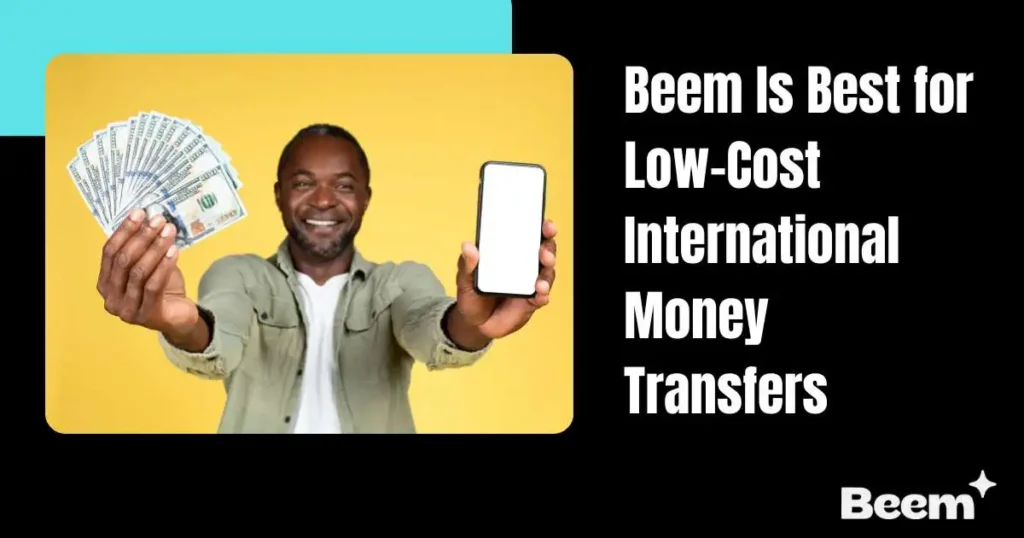At a Glance
With digital payments, transferring money across borders has become a common need for many individuals worldwide. Send money securely across borders to ensure your funds reach the right hands without risk.
It is essential to see your hard-earned cash safely into the hands of its intended recipient, whether you are dealing with global business payments, investing abroad, or supporting foreign-based family members. Let’s discuss the safest ways of money transfers, why choosing the right or best service is essential, and some advice on securing your money and data.
Apps like Beem offer a secure and straightforward way to send money online. With transparent fees and fast transfers, it’s a reliable choice for everyday cross-border payments.
1. Why Security Matters in Cross-Border Transfers
Cross-border money transfers take more than a single click of the button. Each transfer moves through several banks, intermediaries, and online platforms, offering many exposure points. As cross-border payments increase, so too do the threats.
Cases of cross-border payment fraud, phishing scams, and identity theft are rising. You may be targeted with false payment requests, your sensitive information may be leaked, or you may act as a genuine service provider. A single error can lead to lost funds, delayed support for loved ones, or severe privacy violations.
In addition, when money moves across borders, tracking and retrieving become much more challenging. For this reason, it is essential to ensure a safe transfer. Keeping your money and personal information secure is more important than speed or convenience.
2. Choose a Secure and Reputable Transfer Service
When transferring money abroad, the service provider you use significantly impacts the security and hassle-freeness of the process. With so many choices available these days, selecting one that offers reliability, robust security measures, and positive customer reviews is crucial.
Use Trusted Platforms
Begin by selecting services with an established record. Known names such as Wise, Remitly, Western Union, Xoom, PayPal, and Revolut are popular for international transfers and are transparent and secure in their dealings.
All these platforms provide various transfer methods, from bank-to-bank to wallet transfers and even cash pickups. Above all, they work on strict regulatory regulations, making the transaction process safer.
In the U.S., trusted services are registered with the Financial Crimes Enforcement Network (FinCEN) and follow AML and identity verification guidelines, adding another layer of protection.
Security Features to Send Money Securely Across Borders in 2025
Good transfer services must prioritize the safety of your data and funds. Consider:
- SSL encryption safeguards sensitive information while in transit.
- Two-Factor Authentication (2FA) is used to log in and approve accounts.
- Fraud detection systems to mark suspicious activity.
- Real-time tracking gives you an idea of where your money is at each step.
- Alerts and notifications will be sent to update and inform you of any changes or developments.
These characteristics provide multiple levels of protection, making it more difficult for unauthorized individuals to access your data or intercept your funds.
While money transfer apps are not FDIC-insured like traditional bank deposits, many still implement advanced security measures—such as encryption, account monitoring, and fraud detection—to help keep your funds and personal information safe.
Read Reviews and Ratings
Research user feedback before investing in a service. Visit sites like Trustpilot, Google Reviews, or online consumer forums to gain insight into real-world experiences.
Notice common review threads—general praise for reliability and customer support is a positive sign. Conversely, frequent complaints about surprise fees, slowness, or bad service should be warning signs.
3. Verify Recipient Information Carefully
Regardless of how secure your transfer process is, a single error in recipient data can compromise the entire transaction. A wrongly spelled name, incorrect account number, or incorrectly typed code can result in delay, misplaced money, or even permanent loss. Double-checking details is one of the most significant steps in sending money safely overseas.
Double-Check All Transfer Details
Before you finalize any transaction, take a quick look at each bit of information:
- Recipient’s full name (as shown on their bank account or ID).
- Account number or wallet number, depending on the transfer type.
- SWIFT/BIC and IBAN codes for international bank transfers.
- Mobile number or email address, if transferring money using digital wallets like PayPal or Revolut.
Even a single digit off in a SWIFT or IBAN code can send your money to the wrong account, and correcting the error might take days or be impossible. Always copy and paste details when possible to avoid typos.
Communicate Through Trusted Channels
For security and to protect both you and the recipient, always verify payment information through safe and direct communication:
- Call the recipient directly to validate wallet IDs or account numbers.
- Utilize end-to-end encrypted messaging apps such as Signal, WhatsApp, or iMessage.
- Never send or receive sensitive financial information via public forums, email, or unencrypted chats.
Thieves can intercept or spoof public forums. If you are sent updated payment information via email, check with the recipient via a second secure channel before acting on it. Attackers tend to pose as recipients in an attempt to divert funds.
Check our guide on How to Ensure Your International Money Transfers Are Secure
4. Avoid Common Scams and Fraud Risks
Scammers commonly target people who send money overseas, employing clever tactics to steal money or personal information. If they are unaware of the warning indicators, even the most cautious users might become victims of a convincing fraud. These are the most typical scammer tactics to watch out for, along with tips on staying clear.
Phishing Emails or Fake Transfer Websites
- Always use transfer platforms from their official website or mobile app.
- Never click on links from unfamiliar emails or messages.
- Check the padlock icon and “https://” in the address bar before inputting your info.
When something seems suspicious, such as an unfamiliar sender address or a sense of urgency, don’t respond. Please visit the company’s website directly to verify the information.
“Urgent Help” Requests from Unknown Contacts
You may get messages claiming that a person is stranded overseas, urgently needs medical assistance, or is held up at customs—all wanting you to send them money in a hurry. These are emotional manipulation scams aimed at getting you to act impulsively without thinking.
How to be safe:
- Regardless of how desperate the plea sounds, don’t send funds to strangers or unknown contacts.
- If the request looks like it’s from someone you know, check through another means—a rapid phone call can tell you if it’s authentic or not.
Some scammers hack social media sites or email addresses to pose as individuals you trust.
Overpayment Refund Scams
Widespread in freelance or business transactions, this type of scam is where a scammer “accidentally” sends you more money than you are supposed to get and then demands you send back the excess amount. The initial payment is usually fake or reversed later.
Tips for being safe:
- Don’t make refunds unless a payment is fully cleared by your bank and verified.
- Be wary if someone demands you send money back promptly.
- Be mindful of atypical payment techniques or requests that do not fit the usual business procedure.
Last tip: Follow your gut. If it doesn’t feel right, slow down and review the details. Scammers count on urgency and confusion—keep your head, double-check, and don’t rush to send money.
5. Fund Transfers Using Safe Methods

Deciding how to send money is as crucial as deciding where and to whom. Safeguarding with secure, traceable, and covered channels reduces fraud and unauthorized access risks. This is how to make your transfers secure from beginning to end.
Use Bank Accounts or Verified Cards
Use bank accounts or confirmed credit/debit cards to send money abroad. These means are traceable, monitored, and provide enhanced fraud protection.
Things to avoid:
- Unregulated crypto wallets are typically anonymous, difficult to track, and commonly used in scams.
- Prepaid cash cards or gift cards—Scammers commonly ask for these since they’re virtually impossible to retrieve once sent.
With legitimate financial institutions or regulated money transfer services, there is a clear record of transactions and backup in case something goes wrong.
Avoid Public Wi-Fi During Transactions
Airport, café, or hotel public Wi-Fi connections may look convenient, but are frequently unsecured. Hackers can capture your data in transit, revealing personal or financial information.
Always:
- Use a secure, password-protected Wi-Fi link.
- Use a VPN for extra protection while traveling or using remote connections.
- Don’t log into financial apps or send transfers using public networks.
Enable Two-Factor Authentication
Two-factor authentication protects the top of your transfer apps and online accounts. Even if someone hijacks your password, they’ll also require a second verification process, such as a code sent to your phone, to get in.
What to do:
- Enable 2FA on your money transfer apps and email accounts.
- Employ authentication apps such as Google Authenticator or Authy for additional security beyond SMS codes.
- Update passwords regularly and keep them under watch.
Read more on The Most Secure Ways to Send Money Internationally
6. Track and Confirm the Transfer
Your job isn’t quite done once you’ve initiated a cross-border money transfer. Monitoring the transaction and confirming its delivery is as important as sending it securely. Tracking ensures your money reaches the right person, while confirmation helps close the loop with peace of mind. Here’s how to stay in control until the funds land safely.
Use Services That Offer Tracking
Not all transfer services are alike—some provide comprehensive, real-time tracking, others do not. Opt for platforms that provide clear status updates throughout the transfer process.
Seek services that provide:
- Real-time email, SMS, or app notifications.
- You can use a reference number to check back in for the transaction.
- A visual progress marker in the app or dashboard.
- Estimated delivery times, so you can tell when the money should arrive.
This transparency lets you notice delays early and provides a paper record if any problem occurs.
Ask the Recipient to Confirm Receipt
Even when you receive a “successful” notification, verify with the recipient that they’ve actually received the money, particularly if the funds are urgent or amount to a large sum.
What to do:
- Get them to acknowledge the precise amount received and the date.
- Ask for a screenshot or confirmation message on their side, if necessary.
- For cash pickups, confirm they’ve picked up the money and corresponded with the reference number.
This final step is a quick method to end the transaction and promptly address any potential problems.
7. What to Do If Something Goes Wrong
Despite taking all precautions, things may sometimes go awry—money fails to show up, goes into the wrong account, or you get scammed. Faster action and taking the correct course can increase the likelihood of recovering funds or minimizing losses.
Contact the Service Provider Immediately
Your first step should always be to contact the transfer service you utilized.
Why it matters:
- Most platforms have dispute resolution or refund request procedures, particularly if the money has not been received or credited yet.
- Some services can suspend or reverse a transaction if detected early enough.
- Reporting the issue enables them to investigate and potentially trace the payment.
- Include all the relevant information: transaction ID, amount, recipient details, and description of the issue.
Notify Your Bank or Card Provider
If your bank account or credit/debit card was used in the transfer, inform your bank or card issuer immediately.
They can provide:
- Chargebacks for unauthorized or fraudulent transactions.
- Temporary holds on accounts to avoid additional loss.
- Inquiry into suspicious activity that might facilitate recovery.
- Acting quickly increases the chances of preventing or reversing fraudulent activity before it is completed.
Report to Local Authorities or Cybercrime Portals
Even if the money cannot be recovered immediately, reporting the case can protect others and be helpful when recovering it in the future.
Where to report:
- National cybercrime portals (e.g., ReportFraud.ftc.gov in the U.S., ActionFraud.police.uk in the UK).
- Local police departments.
- Consumer protection agencies or financial ombudsperson offices.
- Document your report and pass on any subsequent information to your transfer service provider for follow-up.
Don’t delay. The earlier you report, the higher the chances of solving the problem. Rapid reporting, clear documentation, and tenacity are the keys to managing international transfer issues safely and effectively.
How to Send Money Securely Across Borders: Final Tips
If you use wise practices, sending money abroad can be secure and hassle-free. Stay on approved websites, carefully verify the recipient’s information, and avoid using public networks while making payments.
Watch for frauds, including phishing, demands for immediate help, and overpayment schemes. Always trace your payment and verify receipt with the payee. In case of any doubt, move quickly—call your provider, alert your bank, and report the situation.
Beem lets you send money online for free—including gift cards, prepaid cards, checks, and more—instantly to anyone, even those without a bank account. It is one of the easiest and most trusted ways to send money securely across borders.
Always treat money transfers like digital cash. Once your money is in someone else’s hands, it isn’t easy to get back. Guard every step, and your money will arrive safely.
FAQs
Are cross-border transfers secure in 2025?
Yes, they are secure when using licensed and reputable services with encryption and 2FA.
Always double-check recipient details and avoid public Wi-Fi while sending money.
Choose platforms regulated by authorities like FinCEN for added protection.
Are money transfer apps FDIC insured?
No, most money transfer apps are not FDIC-insured. However, they use security features like encryption and fraud detection to protect your funds.
How can I avoid scams when sending money abroad?
Avoid clicking unknown links, double-check recipient details, use secure channels, and never send money to strangers or unverified contacts.
What if I sent money to the wrong account?
Contact your transfer provider immediately. They may be able to reverse the transaction if it’s reported early enough.






